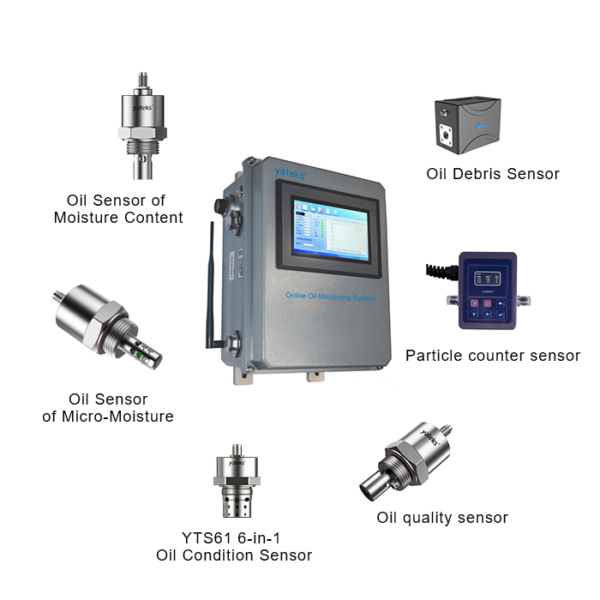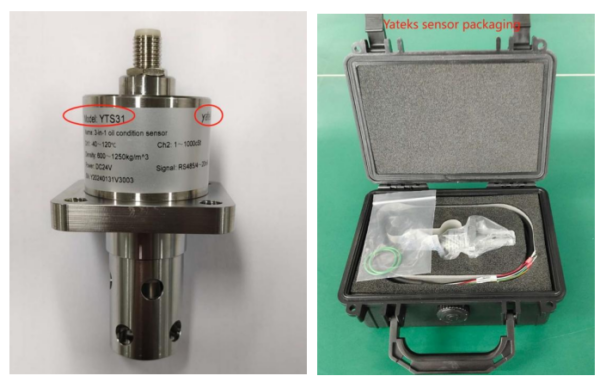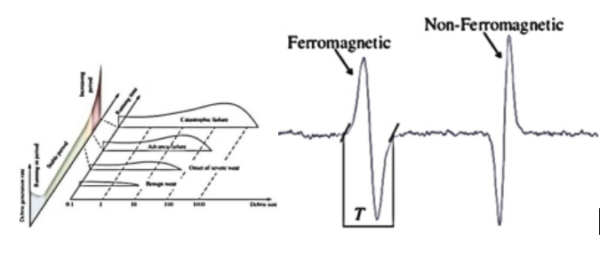1. Does the sensor require cleaning periodically? (As, we understand that the debris may accumulate over time.)
–[Yateks]: Yes, you are right, we have included the detailed sensor cleaning operation and precautions in Yateks sensor user manual. The cleaning operation time period depends on the actual condition. It is recommended to clean the sensor at least every three or six months.
2. How does the filtration affect the sensor? (Do you have any application guides for our understanding (before filtration or after)?)
–[Yateks]: It depends on your purpose. Some customers choose to install sensor both before filtration and after filtration if they have enough budget. Some customers only choose to install sensor after filtration to monitor if the oils are in good health condition and in good service.
Sensor installed before filtration, the sensor measurement is telling you real oil conditions;
Sensor installed after filtration, the sensor measurement is telling you whether the oils after filtration is good to continue using or need to change with new oils, or need to check if the filtration device is in good performance.
3. What does the Oil Condition output represent?
– For instance, what values would indicate a fault (for example, issues with bearings) or the state of change in the oil or filtration?
–[Yateks]: Below are the measurement parameter output of Yateks oil sensor. Usually we suggest end users comparing the oil properties and each parameter’s changing trend to get an early stage warning for predictive maintenance.
For example, if we see the parameter is greatly increasing or decreasing, it’s time to take online oil sample to do lab analysis, to check the exact problems of the oil and track the root reason under further deep analysis.
For bearing condition, with Yateks YFM-8 wear debris sensor measurement of ferrous particles counting and Non-ferrous particles counting, we can acknowledge how much quantity wear particles contain in current gearbox oil vividly, and tell the current wear degree of bearing or gear.
For filtration application, through the viscosity value, water activity, moisture content and particle counting difference before and after filtration, you can have a clear sense on the current oil cleanliness status.
| Yateks oil sensor measurements | |||
| Parameters | Measurement Range | Accuracy | Sensor model |
| Viscosity | 1~1000 cSt | ±5%~±8% | YTS61 |
| Density | 600~1250 kg/m³ | ±2% | |
| Water activity (Saturation / Humidity) | 0~1 aw(0~100%) | ±0.03aw (±3%) | |
| Micro-moisture content (dissolved water in oil) | 0~2000 PPM | ±10% or ±10PPM (whichever the larger) |
|
| Oil Quality (Dielectric constant, oil aging status) | 1~6 Level | ±5% | |
| Temperature | 0~100 °C | ±0.5℃ | |
| Water content (free water & emulsified water in oil) | 0~20% | ±0.5% | YTS-W-1 |
| Wear particles (Fe particles & Non-Fe particles) | Fe particles >40um; Non-Fe particles >150um | The detection rate is not less than 80% | YFM-8 |
| Contamination measurement, solid particles counting | 1~100um; Eight channels (Complys NAS1638, ISO4406) | ±1 pollution level (Particle counting :±20% | YFJ-4 |
4. Would it be possible to remotely configure/calibrate the sensor?
–[Yateks]: Yes, Yateks provides calibration software for Yateks oil sensor calibration, but this is only available for our signed agreement distributor /partner.
You’re right, it’s pretty important for sensor calibration after a period time of use, in order to keep outputing accurate measurement in service and guarantee the sensor working in a right way, instead of bringing troubles for end users.
5. Can the oil sensor work in biogas generators (engines, BHKWs?)?
–[Yateks]: The oil sensor will be installed on engine lubricant oil pipe, so it depends on the engine lubricant oil condition. Yateks oil sensor requires the online pipe pressure less than 10bar and online oil temperature less than 105℃.
Therefore, if the engine lubricant oil temperature within 105℃ and pressure less than 10 bar, Yateks oil sensor can work in biogas generators.
6.How does Yateks oil condition sensor differ from other brand oil sensor ?
[Yateks]: Yateks oil sensor is manufactured by Yateks company, so Yateks team is not only to supply you the oil sensor, but also more importantly to provide you technical support and guide you how to use the sensor in a good way, truly solve your problem and be helpful. What’s more, one purchase, lifetime after-sale service.All Yateks oil sensors have got the CE certificate.
Regarding the difference, do you have any special requirements for the parameters or what’s your budget for the oil sensor? I can write a comparison sheet for you and show you the difference with other brand sensor for your look.
7. To understand the digital outputs of the sensor, can the user manual be shared with us?
–[Yateks]: Yes, sure, I enclosed the YTS61 sensor user manual for your reference. For RS485 digital signal output, we will provide you detailed RS485 communication protocol and assist you to connect it to your system. In addition, we also provide you Yateks sensor software to help you connect it to your computer to easily read the sensor measurement output.
8. Do you have certifications for the EU and the UK, such as UKCA, RoHS, and for instance IP68, Shock & Vibration and EMC?
–[Yateks]: We have got the EMC certificate, I enclosed the EMC certificate and test report for our YTS61 sensor and YFM8 sensor for your reference.
9. Do you produce while-label products? (Can we have our own branding, how much would this change the pricing?)
–[Yateks]: Yes, we can support our partner with while-label products, we call it OEM version and rebrand it with your Logo.
For OEM version oil condition sensor, we require MOQ of 10PCS. We usually change the label sticker with OEM model name and logo paste on sensor. If you can accept such label sticker, we will support you free of charge.
See below pictures of label sticker and packaging of our oil sensors.
If you have other ideas of OEM logo label, please explain to me your requirements, I will check with our engineers if we can do and the cost accordingly.
10. Can you help with the installation in the EU? What are the costs around this?
–[Yateks]: Firstly, once we reach an agreement of partnership, whenever you need, we will arrange online training and demonstration for Yateks sensor installation for your engineer team, assisting your engineers to understand sensor installation. If there is any specific project, we can arrange online meeting to discuss in detail about the sensor installation according to the actual situation and requirements. Of course, the online training is our technical support for our partner and free of charge.
Secondly, if you need Yateks engineers to come to your company for face-to-face training, just need your help to bear the round-trip airfare and accommodation expenses. If you need Yateks engineers to come to there to support on-site installtion work for specific projects, that’s Ok and the same —need your company to bear the round-trip airfare and accommodation expenses.
Thirdly, we have partners in France who is very familiar with on-site installation. If you can accept, I’m glad to introduce them to you to discuss how to work with you about on-site installation in EU.
11. I understand. However, we wanted to point out that we are looking for a more open source configuration/calibration interface to the sensor, as we would like to minimise travel to visit our clients. We would like to achieve this via IO-Link or ModBus RTU. Would this be possible without an agreement as NDAs can be restrictive for us, we would like to definitely avoid at this stage?
–[Yateks]: I have asked our software engineer about your requirements and below are the detailed explanation for Yateks sensor calibration software program for your reference:
- We have written the sensor calibration communicationprotocol into each sensor, because we also need to calibrate each sensor on measurement parameters, it’s a very important step tojudge whether the sensor is qualified.
- Yateks provides distributor/partners sensor calibration software program to supply end usersa complete and thoughtful service. This software program is very convenient to operate after connecting Yateks sensor to computer though RS485 A/B and power supply of ±24V, to avoid the complicated communicationoperations of RS485 ModBus RTU protocol.
Therefore, if you want to achieve more open source configuration /calibration interface to the sensor via IO-Link or ModBus RTU, we can support you.
But our engineer is wondering why you want the more open source configuration/calibration interface to the sensor via IO-Link or ModBus RTU than simply use Yateks provide software program tool? Can you help to tell me why? Are there any special reason? I need your help with more information to answer our engineers.
Regarding providing you Yateks sensor calibration software program, it’s company’s policy to sign the partnership and NDA agreement. Without NDA agreement, I can’t get the approval of sending you the sensor calibration software program, not even to provide you other modifications on sensor calibration software to well meet your requirements.
12. We particularly would like to achieve preventive maintenance regarding the bearings of the gas engine. We would like to understand when to change the oil, or look for some internal issue with the engine.
For instance, given a oil quality metric, when would be the best to give an alert to our client?
–[Yateks]: The response of real-time sensor test data is the next step of sensor monitoring, they’re data trend analysis and fault prediction.
For the sensor, its job is only to give the real-time test data of the current situation, and the sensor itself does not have the alarm function.
Regarding the alarm value setting, it is best to confirm according to the actual working conditions of customers. There are some differences in alarm value setting for different equipment and different working conditions.
Usually, the early warning value or caution value is set at 10%-15% of the standard value, and the alarm value is set at 20%-25% of the standard value. This can be used as a reference, and customers can adjust the early warning value and alarm value according to the actual use.
13. Can we get the pricing regarding the all of the sensors that are mentioned and the refund process if we are not happy with the sensor?
–[Yateks]: Yes, Yateks has the RMA policy, if the sensor doesn’t meet declared specification or has quality problem, you can return it to us for a new replacement or refund.
Before you order Yateks sensors, we will provide you quotation include sensor specification, you can see if the sensor specification can meet your demands and then make the decision. If you have any concerns on Yateks sensor, feel free to ask, I will answer you and give you suggestions for your reference.
14. We assume, YFM-8 oil wear debris sensor is an optical laser based sensor, which is similar to IFM’s sensor. We had many issues with such sensor as the installation requires achieving a certain flow rate, which is not easy to achieve within our experience. Therefore, Is there an another way to measure this, as Tan Delta claims that is possible with their sensor?
–[Yateks]: Yateks YFM8 oil wear debris sensor is not an optical laser based sensor, YFM8 is the same principle as Poseidon’s DM4600 sensor.
YFM-8 has built-in two sets of high-performance reverse-wound excitation coils and one set of high-performance induction coils. Both the excitation and induction coils work at resonance. When there are metal abrasive particles passing through the pipeline, the magnetic flux change of the excitation coil is received by the induction coil, and then passed through the high-sensitivity sampling unit, band-pass filter unit, phase and amplitude comparison unit, signal amplification unit, low-pass filter unit and signal extraction unit. The unit completes the real-time capture and reporting of metal abrasive particle signals.
YFM-8 realizes the detection capability of iron particles (Fe) above 40um and non-ferrous particles (Non-Fe) above 150um.
But to give a accurate measurement from YFM-8 sensor, there also have flow rate requirements, the recommended flow is 0.3~0.9 Liter/min OR 0.1~0.3 meter/second.
15. Oil sensor would be clogged in biogas applications due to soot. Do you have this problem with your sensors?
–[Yateks]: Yes, it’s a common problem the sensor. That’s why we suggest to remove the sensor to do cleaning after months’use. On theother hand, we have designed some structure member to assist sensor installation according to customer’s actual on-site situation, in order to reduce the sensor clogged issue due to soot or other contaminates.
We have seen this problem, so we have been planning and developing an automatic device which can support job of sensor testing, sensor cleaning and sensor calibration. But this device is a bit expensive, unit price is around USD 30000.



